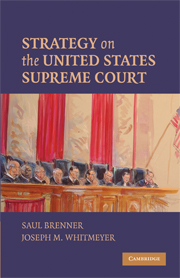Book contents
- Frontmatter
- Contents
- Preface
- PART I INTRODUCTION
- 1 The Legal Model
- 2 The Attitudinal Model
- 3 The Strategic Models
- PART II CERTIORARI
- PART III THE CONFERENCE VOTE ON THE MERITS
- PART IV THE MAJORITY OPINION AND OTHER OPINIONS
- PART V THE FINAL VOTE ON THE MERITS
- PART VI CONCLUDING CHAPTERS
- Appendix 1 Decision Making on the United States Supreme Court
- Appendix 2 Additional Questions to Explore
- References
- Table of Cases
- Index
1 - The Legal Model
Published online by Cambridge University Press: 05 June 2012
- Frontmatter
- Contents
- Preface
- PART I INTRODUCTION
- 1 The Legal Model
- 2 The Attitudinal Model
- 3 The Strategic Models
- PART II CERTIORARI
- PART III THE CONFERENCE VOTE ON THE MERITS
- PART IV THE MAJORITY OPINION AND OTHER OPINIONS
- PART V THE FINAL VOTE ON THE MERITS
- PART VI CONCLUDING CHAPTERS
- Appendix 1 Decision Making on the United States Supreme Court
- Appendix 2 Additional Questions to Explore
- References
- Table of Cases
- Index
Summary
Why do the justices on the United States Supreme Court behave they way they do? In an attempt to answer this question, Supreme Court scholars have posited three theoretical models: the legal model, the attitudinal model, and various strategic models.
Models, according to Segal, Spaeth, and Benesh (2005, p. 20), are “a simplified representation of reality. They do not constitute reality itself. A good model serves two contradictory purposes: It accurately explains the behavior in question and it does so parsimoniously, that is, sparingly or frugally.” One can always maintain that a given model explains the behavior, but in science we expect models to be testable or falsifiable. A simple model might be easier to test and may be accurate enough especially when used to explain behavior averaged over a large number of people or for a long period of time. The legal model is the traditional, nineteenth-century explanation of why the justices behave the way they do. Advocates of this model posit that the justices decide cases based on their interpretation of the relevant legal materials. These materials include the U.S. Constitution, federal and state statutes, local ordinances, and the Court's precedents.
The legal model is insufficiently explanatory of decision making on the Court because the justices usually have to interpret ambiguous legal texts and it is uncertain how they ought to do so.
- Type
- Chapter
- Information
- Strategy on the United States Supreme Court , pp. 3 - 10Publisher: Cambridge University PressPrint publication year: 2009

